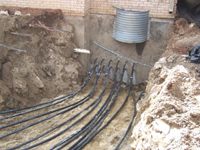Bertrand Well Drilling
Geothermal Wells
Standing Column Wells
This type of well is typically drilled into bedrock to a pre engineered depth based on the heating cooling load of the building. Most systems average well depth is between 700'-1500'. A PVC liner is installed to the bottom of the well with the end of the liner ported forcing the water to be drawn form the bottom of the well. A submersible pump is installed inside the liner which pulls the water from the bottom of the well. The water is moved through the heat pump and then returned back to the well via a return line which is located on the outside of the PVC liner and the inside of the casing.
Standing column wells is recommended for locations that have limited amount of space or don't want to use up their land with multiple boreholes. Standing column wells also is constructed so that the water in the well can be used for drinking or irrigation.
New England geology has bedrock near or close to ground surface in most locations, making these systems suitable for this area. Water encountered in the fractures of the rock provide the heat necessary for the heat exchange.
Advantages of standing column geothermal system are:
- Occupies less land with only 1 well for a typical residential system
- In most cases is more thermally efficient than closed loop
- Standing column wells can serve the duel purpose of supplying the home with heat and water.
- No antifreeze solutions being used
Closed Loop

These wells can be installed either above bedrock or into bedrock depending on site conditions and the depths and number of wells needed are pre engineered based on the heating and cooling load of the building. Typical closed loop wells are installed to depths between 200'-500'.
High density polyethylene (HDPE) loop is placed into the well with a u bend placed at the bottom of the well. The HDPE loops are filled with environmentally friendly antifreeze solution. The HDPE allows heat transfer between the earth and the antifreeze solution.
Installing a thermal conductive grout in the boreholes in their entirety from the bottom up provides the thermal conductivity between the earth and the heat exchanger necessary to produce the most efficient system. Grouting also prevents surface water from flowing down the borehole and entering our groundwater.

The entire well is then grouted from the bottom to the top using a special mixture of thermally enhanced grout. Each well in the series is connected together to a header system using special fusing techniques which renders the connection as strong as the pipe itself. Pressure testing is necessary to assure there are no leaks in the system.
Both the supply line and the return line are brought into the foundation.
Advantages of a closed loop system:
- Used in areas where limited or no water is available
- Once the loops are installed and buried the system is out sight and area can be used for driveways, lawns, and other surface activities.